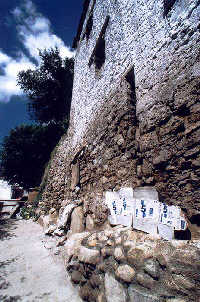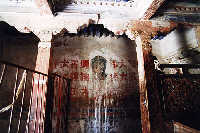|
Zhaibung Monastery:Tibet's Largest Monastery
( 2005-10-14 )

The Zhaibung Monastery, which in Tibetan is called Duimi or Gyimi monastery and means "an auspicious land," sits at the southern slope gully of the Gebeiwoze Mountain about 5 kilometers west of downtownLhasa. It is the largest monastery in Tibet.
The Zhaibung Monastery was built in 1416 by Jamyang Qoigyi Zhaxi Bendain, a favorite disciple of Master Tsong Khapa, founder of the Gelug (Yellow) Sect of TibetanBuddhism. It is one of the six Gelug monasteries in China, but with the largest area and the highest status since it is the "mother monastery" of the Dalai Lama.
In 1409, Master Tsong Khapa succeeded in pioneering the Grand Summons Ceremony, also called Molan Qenmo in Tibetan, in the Jokhang Monastery, Lhasa. In the same year, he had the Gandain Monastery built in response to the popularity of the Gelug Sect among Tibetan Buddhists. With the official rise of the Gelug Sect, the Zhaibung Monastery was built to accommodate the new situation.
When the Zhaibung Monastery was built, Mamyang Qoigyi Thaxi Bendain served as its first abbot, also called Chiba in Tibetan. The monastery has had 23 abbots.
In 1464, the Zhaibung Monastery set up Buddhist colleges, or Zhacang in Tibetan, for monks to learn Buddhist classics. During the period of the 5th Dalai Lama, the Gelug Sect set a ceiling on the number of monks for each Gelug monastery. The number for the Zhaibung monastery was more than 7,700 monks, which made it the largest in Tibet -- the number of lamas at Gandain Monastery was about 3,300 and 5,500 atSera Monastery.
The Zhaibung Monastery is composed of the Coqen Hall, four Zhacang colleges (called Losailing, Deyang, Ngaba and Gomang Zhacangs) and the Gandain Phodrang (Palace). They formed the management organ, which functioned under Coqen. The four colleges contain a total of 29 Kamcuns, groups of monks formed in accordance with their origins. Zhacangs) and the Gandain Phodrang (Palace). They formed the management organ, which functioned under Coqen. The four colleges contain a total of 29 Kamcuns, groups of monks formed in accordance with their origins.
Located in the central part of the Zhaibung Monastery, the Coqen Hall covers an area of close to 4,500 square meters. In front of the hall is a square paved with stones. A 17-step stone staircase links the square with the hall. At the entrance are eight pillars. Coqen's Sutra Hall is of magnificent scale, covering an area of 1,800 square meters and propped up by 183 pillars. All the Buddha statues enshrined in the Coqen Hall are lifelike, such as the statue of the Wisdom Buddha and a statue hidden under a whiteumbrellain the central part of the Coqen Hall.
There are two silver dagobas in the wing chambers of the Coqen Hall. These are holy stupas for the 3rd and 4th Dalai Lamas. The Duisong Lakang (Hall) in the rear part of the Coqen Hall is the earliest of its kind in the Zhaibung Monastery. Jamyang Qoigyi Zhaxi Bendain used to sit in mediation and study here. Now, it is enshrined with the statues of the 3rd Dalai Lama and two of his favorite disciples.
Zhacang colleges are where Gelug monks studied Buddhism. In the early days of its construction, the Zhaibung boasted seven Zhacangs, all of which were put under the seven major disciples of Jamyang Qoigyi Zhaxi Bendain. With the increase in the number of monks hailing from other monasteries who studie in these Zhacangs, the seven Zhacangs were condensed into the Losailing, Gomang, Deyang and Ngaba Zhacangs in accordance with the contents of the disciplines and origins of the students. The first three Zhacangs are for the study of the open school of Tibetan Buddhism, and the fourth is the Tantric college.
Southwest of the monastery is the Gandain Phodrang Palace, the residence of the 2nd to the 5th Dalai Lamas.
All the buildings of the Zhaibung Monastery are closely laid out. Each building is composed of a courtyard, a Sutra hall and a Buddha hall. The terrain rises from the gate to the Buddha halls to highlight the position of these halls to highlight the position of these halls. The Coqen Hall is the largest; the Deyang Zhacang is unsophisticated in layout; the Ngaba Zhacang is compact; and the Gandain Phodrang is the most magnificent. All the buildings have golden tops, Dharma wheels and other religious objects.
 The Zhaibung Monastery preserves close to 10,000 ancient classics, more than 100 volumes of Gangyur and 100 volumes of Dangyur, and hundreds of volumes of hand-copied works by Zongkapa and two disciples. Buddha statues enshrined in various Buddha halls, lifelike as they are, represent a high level of sculpture within Tibet. Color frescoes in these halls are elegant. All the the art is valuable for the study of Tibetan history, religion and art. The Zhaibung Monastery preserves close to 10,000 ancient classics, more than 100 volumes of Gangyur and 100 volumes of Dangyur, and hundreds of volumes of hand-copied works by Zongkapa and two disciples. Buddha statues enshrined in various Buddha halls, lifelike as they are, represent a high level of sculpture within Tibet. Color frescoes in these halls are elegant. All the the art is valuable for the study of Tibetan history, religion and art.
During the Shoton (Sour Milk Drinking) Festival held by the Zhaibung Monastery on the 30th day of the 6th month in the Tibetan calendar, a huge portrait of Sakyamuni is hung from Genewoze Hill. Tens of thousands of Buddhist followers and visitors come to worship during the grandest event of the year at the monastery.
|

